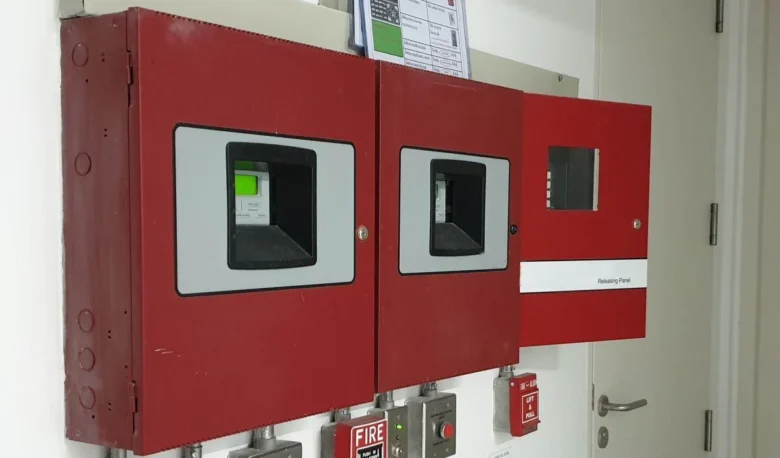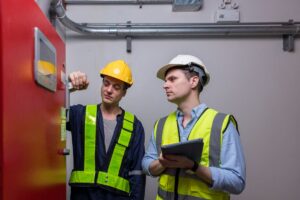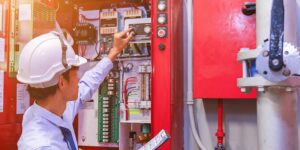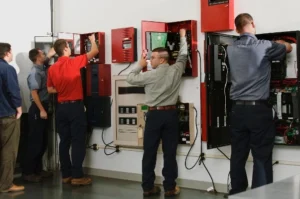Fire safety is critical in both homes and businesses. Most people know what smoke detectors and fire alarms are, but few know the systems that quietly watch over them and ensure they are always ready for emergencies. Fire alarm systems are essential to ensuring that fire protection systems are functioning properly, as they monitor important firefighting equipment and alert people when problems arise. These methods help prevent problems before they occur and ensure that buildings are always safe. To fully understand how these systems improve safety, you need to understand their key components and how they work together to prepare the entire system for fire.
Command Center
The control panel is the heart of any fire alarm system. It is the brain of the entire system; it gathers information from connected devices and determines when an alarm should be sent. The control panel is set up to understand the normal response of the system and report problems such as closed valves, low water pressure, or power outages. When an abnormal condition is detected, the control panel processes the data and activates an alarm or warning system to alert people in the building or the alarm center of the situation. Modern control panels also provide technicians with detailed reports and tests that allow them to quickly identify and resolve problems.
Main Switches
Tamper switches are an important tool for monitoring the status of important components, such as water system control valves. They mainly detect valve settings that should not be changed or may be changed by accident. For example, if someone intentionally or accidentally turns off a water valve, the tamper switch will alert the control panel. This will trigger a monitoring alarm. This alarm will alert building management that the sprinkler system may not be working properly in the event of a fire. Tamper switches are a simple and effective way to prevent system failures due to human error.
Water Flow Switches
Another important component of a fire monitoring system is a water flow switch. These switches are installed in the sprinkler lines to monitor the flow of water when the sprinkler system is activated. Their main purpose is to detect fire hazards, but they also help to check if water is flowing when it should not be, such as in the event of a leak or problem. In either case, the button alerts the control panel that there is a problem, which activates the probe. By monitoring the flow of water, these switches help maintain the stability of the system and prevent leaks and accidental spills from causing greater damage.
Water Level and Pressure Sensors
Many fire suppression systems depend on a constant flow of water and the correct amount of water in the tank to function properly. In water tanks, fire pumps, and sprinkler lines, pressure sensors and water level indicators continuously monitor these conditions. These monitors alert the control panel if the water pressure drops below a certain level or if the water level in the tank is too low. This early detection is very important, because a lack of water in an emergency can lead to the failure of the entire fire protection system. Pressure and level monitors ensure that the system is always ready by continuously monitoring these factors.
Monitoring relays
Monitoring switches are control devices that oversee the power supplies and electrical components essential for fire protection systems. They are usually connected to alarm systems, fire pumps and other power supplies. Monitoring switches alert the control panel of power failures, circuit faults or other electrical problems. The control panel then emits a warning signal. This function is very important in large buildings, because power failures can cause important fire protection equipment to fail. Monitoring switches protect the electrical backbone of the system and ensure that it is always working properly.
Valve monitoring switches
Valve monitoring switches are used to monitor the position of the water system’s control valves. In order for the sprinkler system to function properly, these valves must remain open. The switches alert the control system when the valves are closed, whether intentionally, for maintenance or accidentally. This allows the problem to be resolved immediately, allowing the valve to be reopened and full fire safety to be restored. Without this inspection, the closed state of the valve may not be discovered until a fire breaks out, where
power, motor, pump status and more. The controller communicates with the fire alarm system to ensure that the pump is always available in case of an emergency. The controller can sound an alarm to inform building managers of performance or maintenance issues so that they can be fixed before they become a problem.
Alarms and warning devices
Many fire alarm systems run in the background but are not detectable. However, it is crucial to be able to warn people when something goes wrong. When the control panel receives information that a problem has occurred, alarms and warning devices such as bells, horns, flashing lights and digital displays light up. These devices immediately notify building staff, residents and alarm centers of potential problems so that they can be fixed quickly. Some systems also allow for notifications to be sent via text message or email so that people who are not on site can also be informed of the situation. Notification devices ensure that data from the fire alarm system is used to take action in the real situation and get help at the right time.
Communication and monitoring modules
Many modern fire alarm systems are equipped with high-tech communication units that can communicate with external tracking stations or building management systems. These units send data and information to people who are not on site via radio, mobile phone or internet signals. This connection ensures that problems can be discovered and solved, even when the building is empty or not in use. Technicians and emergency responders can access the fire alarm system remotely to check the status of the system and make quick decisions. This good connectivity makes the entire fire protection network more reliable and effective.
Interface for maintenance and test functions
Fire alarm systems must be checked and tested regularly to ensure that they are functioning properly. Most systems have built-in test functions and support tools that are easy to use for everyone. Authorized users can use these tools to perform tests, view system logs and check that each component is functioning properly. Some systems are operated with a keypad, others with a touchscreen with visual guidance. The system is tested and checked regularly to ensure it meets fire regulations and is always ready for emergencies. Maintenance tools built into the monitoring system make regular checks faster and reduce the chance of human error.
Summary
Understanding the key components of a fire alarm system will help you understand how important they are to complete fire protection. From safety switches and pressure monitoring to control panels and communication units, each part of the fire protection infrastructure works in its own way to ensure it is always available and reliable. The monitoring system ensures that fire safety equipment is functioning properly when it is needed most by continuously monitoring valves, pumps, power supplies and water supply. This not only protects property and money, but also saves lives by preventing the system from failing at critical times. Investing in a well-maintained fire alarm system is not only a smart move, but a necessity for any safety-conscious building.




